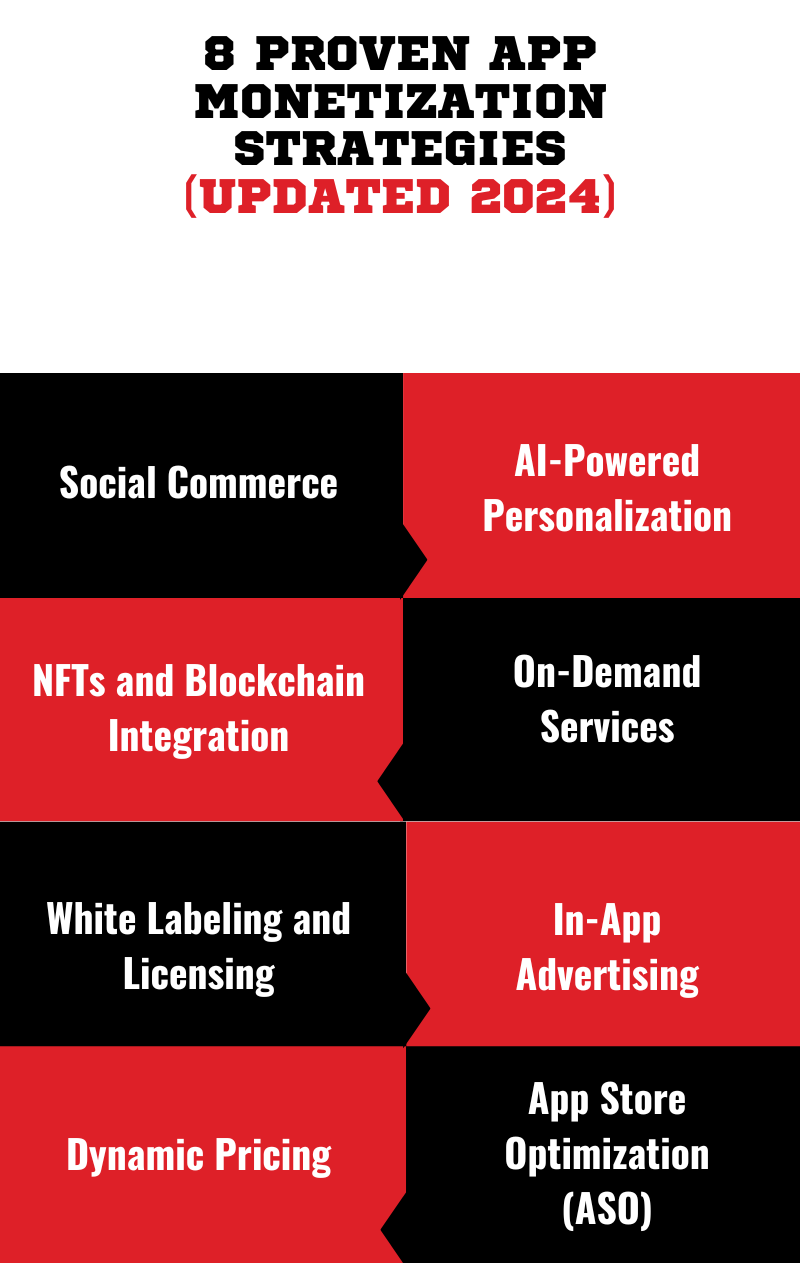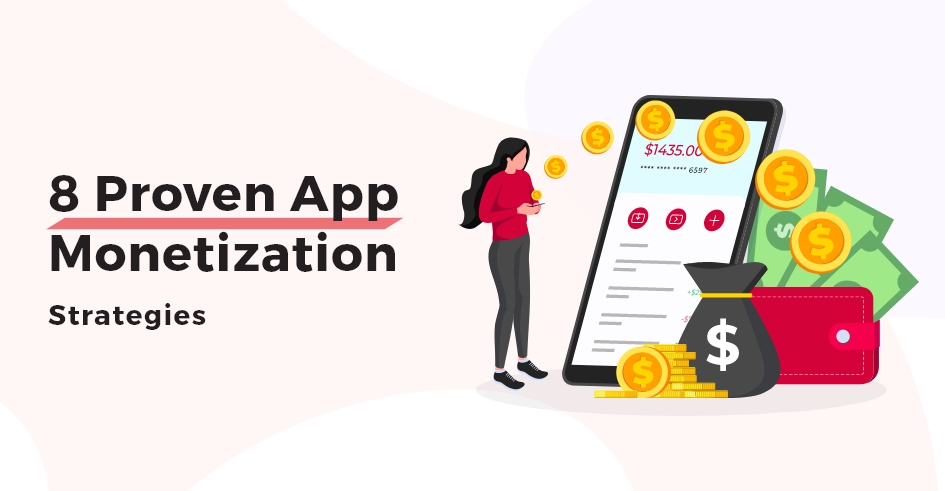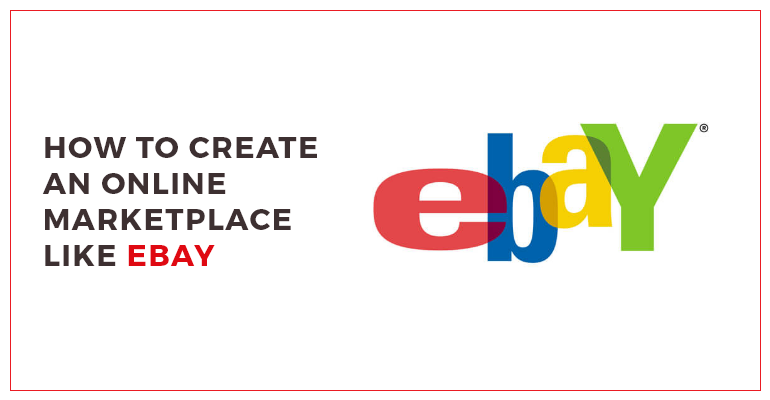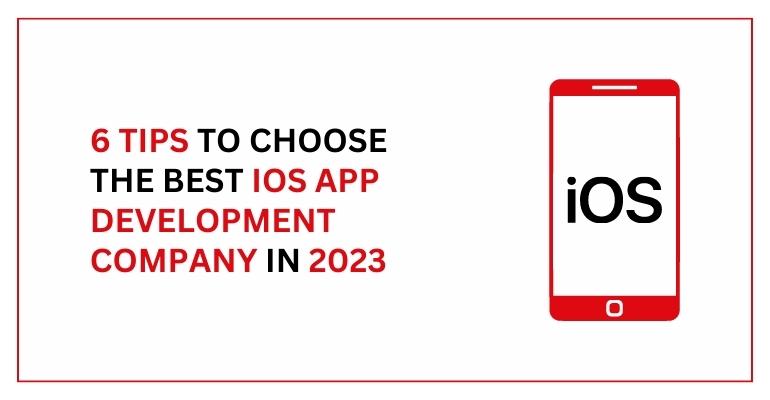We’ve all heard about app monetization and how it can generate enormous revenue streams. With 3.3 million apps on the Google Play Store along with roughly 2 million apps on the Apple App Store, which App Monetization Strategies do you choose to make your app into a money-printing machine?
This guide will explore eight proven strategies for mobile app monetization in 2024, helping you stay ahead of the competition and ensure your app’s financial success.
Is It Worth Investing In App Monetization In 2024?
If you are on this blog, you are eager to learn about App Monetization Strategies, or you’re here to find a way to outpass your competition. The global app market is expected to hit an eye-popping $935 billion in revenue in 2024. Yes, that is close to a —trillion.
Remember when everyone thought Angry Birds was just a fad? Fast forward, and those slingshot-happy birds have catapulted their way to the top, thanks to in-app purchases, ads, and merchandise deals that probably even surprised the pigs. That’s the kind of success that comes from solid App Monetization Strategies, knowing how to make your app mint cash for you.
So, how do you turn your app into a cash cow without alienating your users? Think of monetization strategies as your app’s secret sauce (which we will discuss in the blog later), keeping users coming back for more while filling your pockets.
But it’s not just about slapping on ads or pushing subscriptions like they’re going out of style. It’s about being smart, innovative, and—dare I say—strategic. The competition is fierce; apps are popping up faster than you can say, “There’s an app for that.” But with a well-crafted plan, your app can not only survive but thrive in this bustling marketplace. So yes, app monetization in 2024 is worth every dollar you invest.
Let us now discuss different app monetization models in the next section to give us a heads-up.

App Monetization Models
There are several app monetization models to consider, each with its own set of benefits and challenges. Understanding these models is important in selecting the best approach for your app. These will work best regardless of whether you’re focused on Android app monetization or iOS app monetization.
- In-App Purchases: Users buy virtual goods or premium features within the app. This model is popular in gaming apps.
- Subscription Models: Users pay a recurring fee to access content or features, which are common in streaming services and productivity apps.
- In-App Advertising: Displaying ads within the app, where revenue is generated per click or impression.
- Freemium: Offering the app for free while charging for premium features.
- Sponsorship: Partnering with brands to offer exclusive content or rewards within the app.
- Affiliate Marketing: Earning a commission by promoting other companies’ products within your app.
These revenue streams provide different ways to capitalize on your app’s user base, offering flexibility and opportunities to tailor your monetization approach to your audience.

8 Proven App Monetization Strategies (Updated 2024)
Here are eight proven App Monetization Strategies that will help you generate revenue streams:
- Social Commerce
- AI-Powered Personalization
- NFTs and Blockchain Integration
- On-Demand Services
- White Labeling and Licensing
- In-App Advertising
- Dynamic Pricing
- App Store Optimization (ASO)
Let’s look at them in detail below:
1. Social Commerce
Social Commerce is like the cool kid who just showed up at the party, bringing all the fun gadgets and gizmos. It’s the fusion of social media and e-commerce, allowing users to buy products directly through social platforms without ever leaving the app. Imagine scrolling through your favorite app, spotting those perfect shoes, and buying them with just a couple of taps—all while still watching that cute cat video. That’s social commerce in action.
Fact Check: Pinterest revenue for the March quarter increased by 23% to reach $740 million, while the monthly active user count experienced a 12% growth, reaching 518 million due to their “shoppable pins.” These pins allow users to purchase items directly from the app.
Now, for people searching for how to make money on Pinterest, this is the exact app monetization strategy to generate a full-fledged revenue stream.
2. AI-Powered Personalization
We have seen social media influencers on app like TikTok grow a huge fan base within a short time. Have you ever wondered how TikTok’s “For You” page feels like it was made just for you or how to make money on TikTok? The answer is through AI-powered personalization. Projected global ad revenue for TikTok is expected to approach 18.5 billion by 2024. This has been the most effective app monetization strategy for TikTok and you can grab it too.
AI-powered personalization is like having a personal assistant who knows you as you know yourself. It is a bunch of algorithms working behind the scenes to curate content, ads, and products that perfectly match your preferences. It’s how Netflix always seems to recommend the perfect movie.
For a mobile app development company in Dallas and app developers, AI-powered personalization is a weapon for mass engagement and maximizing earnings. By analyzing user data, AI can predict what content or products a user is most likely to interact with. They can then serve up those personalized recommendations on a silver platter.
Our skilled app developers for hire use this mobile app monetization strategy to create an app that resonates with users. We have a pro tip: Start by analyzing your audience’s behavior. What type of content do they engage with? When are they most active? Use these insights to tailor your content and ads, creating a personalized experience that keeps users coming back for more.
3. NFTs and Blockchain Integration
Woah, NFT development and blockchain integration as an app monetization strategy? People do get surprised, too, when we introduce them to this! Blockchain technology is transforming the way we think about digital ownership and providing creators with innovative ways to monetize their work.
NFTs are unique digital assets that can represent anything from art and music to virtual real estate and tweets (yes, really). Blockchain, the technology behind NFTs, ensures that these digital assets are verifiable and secure, making them valuable commodities in the digital world.
Suppose you’re an artist, musician, or influencer, finding out how to make money on Instagram. Well, good news: this mobile app monetization strategy could be your ticket to a new revenue stream.
Imagine selling your digital art as NFTs directly through an app like Instagram that is, directly by your profile. Each piece of art you create could be tokenized, allowing your followers to buy, sell, and trade your work on the blockchain. Not only does this open up a new way to make money on Instagram, but it also gives your fans a sense of ownership and exclusivity.
4. On-Demand Services
In a world where we want everything today, on-demand services have become the norm. Whether it’s food delivery, ride-sharing, or streaming, on-demand services cater to our need for instant gratification. And guess what? They’re also a goldmine for app monetization.
Take an app like Uber, for instance. It started as a simple ride-sharing service and has since expanded into food delivery, package delivery, and even on-demand helicopters (for the high rollers). The beauty of on-demand services is that they create a constant revenue stream, with users paying for convenience.
If you’re developing an app, consider how you can integrate on-demand services to meet your users’ needs. This could be anything from virtual fitness classes to on-demand dog walking.
Pro Tip: To maximize profits, consider offering tiered services. For example, a basic service could be free with ads, while a premium, ad-free version could be available for a monthly subscription. This way, you’re monetizing every user interaction, whether they choose to pay with time (watching ads) or money (subscribing).
5. White Labeling and Licensing
White labeling is like the unsung hero of the app world. It’s the app monetization process where a product or service developed by one company is rebranded and sold by another. Think of it as the app version of store-brand cereal—it’s the same product as the big brands but with a different label slapped on it.
For a dedicated team of developers, white labeling offers a low-risk way to enter new markets. Instead of starting from scratch, you can license an existing app, rebrand it, and launch it under your name. This not only saves time and resources but also allows you to tap into established markets with a proven product.
Let us understand it using a fitness app example. You’ve developed a fitness app like Built By Determination that tracks workouts and nutrition. By white labeling this app, you can license it to gyms, wellness influencers, or corporate wellness programs, allowing them to offer it as their own branded solution. They get a fully functional app, and you get a steady stream of revenue from licensing fees—win-win!
When white labeling, make sure to negotiate favorable terms in your licensing agreements. This could include revenue-sharing models, minimum guarantees, or exclusive rights in certain markets.
6. In-App Advertising
In-app advertising is like the commercials during your favorite TV show, but way smarter. With in-app ads, you can reach users when they’re most engaged—whether they’re playing a game, scrolling through a news app, or checking out their social feed.
For app developers, in-app advertising is a tried-and-true monetization strategy. The key is to strike a balance between ad placement and user experience. We can say this from experience: Too many ads and users will drop off faster than you can say “ad block.” But with well-placed, relevant ads, you can create a steady stream of revenue without disrupting the user experience.
Consider making a clone app of an app like PUBG. The game offers extra lives or in-game currency in exchange for watching an ad. This model not only keeps users engaged but also incentivizes them to interact with ads, boosting your ad revenue in the process.
You need to experiment with different ad formats to see what resonates best with your audience. These can be banner ads, interstitials, or rewarded video ads. The goal of these App Monetization Strategies is to integrate ads seamlessly into the user experience.
7. Dynamic Pricing
Dynamic pricing is like the stock market for products and services—prices fluctuate based on demand, time of day, or even the weather. For businesses, this is one of the powerful App Monetization Strategies for maximizing profits. By adjusting prices in real-time, you can capitalize on high-demand periods and offer discounts during slow periods to boost sales.
An app like Airbnb is the perfect example of this App Monetization. Ever notice how the cost of booking a cozy cabin in the mountains can vary wildly depending on when you check? That’s dynamic pricing at play—a strategy where prices fluctuate based on demand, timing, and other factors.
This concept isn’t just limited to vacation rentals; it’s a powerful app monetization tool that can be applied to apps, whether you’re offering services, selling products, or delivering digital content.
8. App Store Optimization (ASO)
App Store Optimization (ASO) is like SEO for the app world. It’s all about making your app more discoverable in the app store, driving more downloads, and, ultimately, boosting your revenue. Just like how a well-optimized website ranks higher on Google, a well-optimized app ranks higher in the app store search results.
To nail your ASO, focus on keywords, app descriptions, and visual elements like icons and screenshots. For example, if your app is all about teaching people how to make money on TikTok, make sure those keywords are front and center in your app title and description. This will help your app stand out to users searching for that specific topic.
Partnering with other ASO-optimized apps can be a mutually beneficial App monetization strategy. Here’s how:
- Cross-Promotion: You can promote each other’s apps within your respective apps or on your social media channels. This can increase visibility for both apps and attract new users.
- Shared Resources: Partnering can allow you to share resources like marketing materials, user data (anonymized), and ASO expertise. This can help both apps improve their rankings and performance.
- Co-Marketing Campaigns: You can collaborate on joint marketing campaigns, such as giveaways, contests, or sponsored content. This can create more buzz around both apps and attract a larger audience.
- User Data Sharing (Anonymized): If both apps have similar target audiences, you can share anonymized user data. This can help you refine your ASO strategies and better understand your users’ preferences.
- Joint App Development: In some cases, partnering with another app developer can lead to the creation of a new, joint app. This can offer new opportunities for monetization and growth.
Pro Tip: Remember reviews and ratings. Apps with higher ratings and positive reviews are more likely to be featured in the app store, giving you a significant visibility boost. Encourage your users to leave reviews and address any negative feedback promptly.
Now that you’ve made it this far, TechnBrains would like to give you a free consultation so you can start generating revenue from your mobile app!

Choosing the Best App Monetization Platforms
Picture this: You’ve just launched your shiny new app. It’s sleek user-friendly, and it’s gaining downloads faster than a cat video goes viral. But here’s the million-dollar question (literally): How do you turn those downloads into dollars?
The secret sauce lies in choosing the best monetization platform for your app. The top app monetization platforms for 2024 are:
- 1. Google AdMob
- 2. Unity Ads
- 3. Audience Network
- 4. InMobi
- 5. ironSource
- 6. AppLovin
We’ll explore why platforms like Google AdMob, Unity Ads, and ironSource might just be your ticket to mobile app monetization glory.
Google AdMob is like the Iron Man of monetization platforms—it’s versatile, reliable, and has a solution for almost every problem. If your app is targeting a broad audience and you’re looking to leverage various ad formats (think banners, interstitials, and video ads), AdMob’s got your back.
If your app is a game, Unity Ads is like Mario’s power-up mushroom. It gives you the boost you need by allowing you to integrate video ads seamlessly into your gameplay. This platform is particularly strong in rewarding video ads—a method where players can choose to watch an ad in exchange for in-game rewards.
Facebook’s Audience Network is like the Batman of app monetization—silent, effective, and always one step ahead. This platform uses Facebook’s extensive user data to serve up hyper-targeted ads. If your app is all about social interaction or if it integrates with Facebook, Audience Network can be a powerful tool.
InMobi is like the international spy of the monetization world—able to infiltrate markets across the globe with precision targeting. If your app has a global audience, InMobi can help you reach users in different regions with ads that are tailored to their local preferences.
5. ironSource
ironSource is like the Gandalf of game monetization—wise, powerful, and always ready with a solution. It’s a robust platform designed specifically for game developers, offering tools like in-app bidding, ad mediation, and more.
AppLovin is the all-in-one toolbox for mobile app monetization. It’s like having a whole Avengers team on your side, each member bringing something unique to the table. AppLovin offers everything from user acquisition to ad mediation, making it a powerful platform for apps looking to scale quickly.
Think Wise Before You Monetize
When it comes to selecting the best monetization platform for your app, there’s no one-size-fits-all solution. Consider your app’s niche, audience, and revenue model. Whether you’re targeting gamers, social media enthusiasts, or global travelers, the right platform can make all the difference in turning users into revenue.
At TechnBrains, we understand that every decision in the app development process can significantly impact your bottom line. That’s why we emphasize a thoughtful approach to app monetization, ensuring that your revenue model aligns perfectly with your business goals and user expectations.
Partnering with TechnBrains means more than just building an app; it’s about crafting a solution that maximizes profitability while delivering unparalleled value to your users. Whether you’re considering in-app purchases, subscription models, or ad-based revenue, our team of experts is here to guide you through every step, ensuring that your monetization strategy is not just effective but sustainable.
Ready to make your app a financial success? Let’s connect and explore the smartest ways to monetize your digital assets. With TechnBrains, you’re not just thinking wise—you’re thinking ahead.








